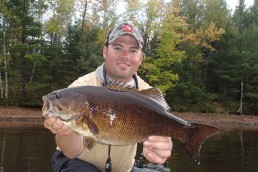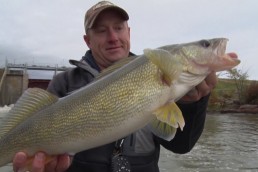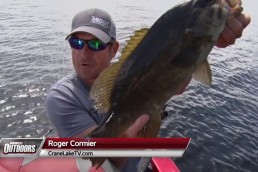Pools of Magic for River Smallmouths
SHARE THIS POST
The great migration happens every year, on every river. When the calendar turns and your river’s water temperature hits its magic number, visit your pools of magic to experience the best river smallmouth fishing of your life.
A wise river rat once tipped me off with confidential information about my local river. His findings were so sensitive and accurate that if his intel was leaked, the river’s fragile smallmouth fishery and secrets could be exposed and put into peril. I was instructed to mark my calendar and prepare for this mass river migration at the start of early fall. The river rat then told me when to fish, and where to float my jon boat in order to reach this magical, untapped smallmouth bass pool. He pleaded for my confidentiality and promise to keep location hush-hush. I followed the wise man’s orders to never tell or bring anyone with me, and reciprocated secrets of my own with him in return.
Grateful for the river rat’s knowledge, I have since observed the same phenomenon he described, and its patterns, taking place on several other river smallmouth bass fisheries besides mine. Luckily for him, every river has its pools of smallmouth magic. Every notable river smallmouth fishery experiences this same mass congregation of staging fish and frenzy of incredible fishing.
As late summer transitions into early fall, river smallmouth fishing patterns and locations change. Fish that would have been dispersed for miles, utilizing mid-current areas of boulder and rock, are now schooling together and staging in deeper, slack-water pools in preparation for their overwintering migrations downstream into flowages. Instinctively, fish will favor deep holes, bends, and flowages where current dissipates and depths are greater. Henceforth, cold nights and the shortening of daylight require river bass anglers like me to make adjustments in fish locations and presentation.
When water temperatures drop into the 60-degree mark and slowly plummet into the low 50s, the bite is on.
The river of dreams
This explosive river fishing window occurs annually, around the third week of September into the first week of October. The movement is always triggered, primarily, by falling water temperatures. Water clarity and current is a secondary, lesser influence. During this period every year, smallmouth bass migrate in masses towards their wintering holes. Along their route, smallmouths will visit and stage in the same holes, annually, until it’s time to eventually move on into their wintering lair.
By nature, adult smallmouths will often re-use and re-visit the same habitats and locations annually. From nesting, to feeding, staging and wintering, they will return each year if they are unexploited and unharmed. Regarding our pool of smallmouth magic, the wise river rat emphasized the same. The fish come here during the same general time, every fall.
At this time, it’s normal to encounter wolfpacks of adult smallmouths, migrating downstream towards their wintering locations. Recent experiences have also shown me that it’s not uncommon to encounter massive schools of big bass that could be numbering and piling up into the dozens, or hundreds.
On October 2nd of last season, I launched my Lund, a shallow-draft fiberglass tri-hull that doubles nicely as a river rig, at my favorite fall stretch of river to fish by myself. Two seasons had passed since my last float trip and visit to this location for fall smallmouths. I carefully motored upstream of the unimproved access to visit my pools of magic. A cold morning (which had dropped water temperatures overnight into the upper 40s) at start time gradually rose by 10 degrees, with aid of sunlight, to nearly hit 60 degrees. Perfect conditions for an excellent bite, I thought.
A dream expedition in real life
With receding water levels enhanced by fall drawdown, good visibility, and my success in locating staging, pre-wintering bass, I ended up experiencing the best river smallie float of my life.
Fishing for only half the day, from noon to 6pm, I caught more giant smallmouth than most anglers catch in an entire season. First 30 minutes in, I caught a 20 inch, three 19 inchers, and a dinky 18 inch. Those quick catches already made my day. Then I camped along the edges of my pool of magic for the next five hours and more big bass bites came in waves. Five more fish here, five more there, five again later. My rate of catching was about five fish per hour as wolfpacks moved in and out thru the pool.
Each smallmouth I caught from the pool was a large adult specimen. Not a single fish caught was less than 18 inches. The largest boated were a handful of 20s and two heavyweights at 21 inches. During most hookups, two to three other following fish were observed swimming together. In such heavy concentrations, the competition for food will be considerably high. What I observed and experienced was truly a massive school of adult, unexploited smallmouths that undoubtedly revisit and stage in this pool annually. Who knows how many more fish beyond the 20 I caught were staging. All 20 fish caught were clean and likely hadn’t touched another angler’s hooks in a long time.

What made my magic pool so special? Besides being a classic river bend with very minimal current, this spot had everything else. Eddies, a distinct channel, bottom comprised of rock, gravel, boulders and wood, depth, and a slow current funneling food down into the packs of fish. In addition, there was a great bottom and depth transition. Shallow sand and vegetation near shore led to a ledge and channel with the hard, palm-sized-rock bottom and wood in depths of 5 to 10 feet. My Lowrance HDS unit’s side imaging confirmed all of this, with schools of smallmouths, football-shaped white blotches swimming together and facing upstream, stacked and sticking out on screen like sore thumbs.
Every notable river smallmouth fishery contains these similar pools of magic. In fact, many prominent river systems will contain several pools. In order to make such discoveries, it takes is a lot of exploration, navigation, and dodging of boulders. And it always helps to know a wise river rat.
Hole hoppin’ strategy
In autumn, 90% of the fish are going to be utilizing 10% or less of the water. Therefore, it’s impractical to cover water and float endlessly as you would during spring and summer. By doing so, you are wasting precious fishing time. Instead, eliminate all that dead water by jumping from hole to hole. Spend considerable time at each deep pool before deciding to move on.
Attack every deep pool with stealth. So that you don’t spook fish, let them know of your presence, and eventually drive them away from the hole, always attack from the downstream side of the pool first. Limit your bow trolling motor use. Anchor yourself to hold as often as necessary. Position yourself and the bow facing upstream and proceed fishing. Additionally, give consideration to positioning tight to the opposite shore of the pool you will be targeting.
It would be wise, at some point, to then target the pool from the upstream side, too, in order to give fish a different casting angle. If your river access site is upstream from a pool of magic, the better strategy would be to fish upstream first. However, in my situation, it’s impractical to do so until the pool’s commotion and fish have settled from being spooked. Instead, I will fish the upstream side of the magic pool after motoring upstream to visit the next pool. Or, while I return downstream.
The right smallmouth presentation
As river water temperatures are ranging from the low 50s to 60, it’s a prime time to fish shallow-diving crankbaits such as Rapala DT 4’s and 6’s and retrieve them with a medium speed through deeper holes. In addition, my top-producers of squarebill crankbaits, Rapala Crankin Raps (05) and Bandit 100’s, fare well, too. All river crankbaits I fish with have one thing in common; red craw pattern. Fish crankbaits first, and fire away!
Cast crankbaits upstream and horizontally into the pool. As you dive deep into undercurrent benthic zones, and bang away at the terrain of the hard bottom, you’ll surely intercept smallmouth.
You will catch the most active fish with crankbaits first. Bites will come quickly, but often dissipate as fish become more conditioned. After one flurry of bites comes and goes, another might soon take place.
You might observe fish chasing the baits, or just catch them as they slightly nip the crank’s rear treble hook. If it wasn’t for Trokar’s TK300 treble hooks I replace my original crankbait hooks with, then no way am I catching these light biters from colder water.
Once staging smallmouths become conditioned to crankbaits, experiment between tube jigs, heavy 1/8- and 1/4-ounce hair jigs, and a combination of hula grubs and football heads. Favorite soft plastics are Strike King Coffee Tubes, and Chompers Skirted Twin Tails. In addition, consider other craw-pattern imitators that include skirted football jigs, such as locally manufactured, Super-K Jigs. Top producer in the jig department for me is the 1/4-ounce finesse football in “orange dream”. If the river system is dominated by a crayfish forage base, imitators like these, fished with jigs to keep you at bottom, will quickly load up on bites.
What they’ll bite if they’re hungry for baitfish
Meanwhile, if baitfish such as mud minnows, white sucker, chubs, shiners and yellow perch encompass the forage base, single Colorado spinnerbaits, and suspending jerkbaits such as Husky Jerks, X-Raps, and Shadow Raps will score fish. Additionally, on some days, 4- to 5-inch flukes, fished on a 1/8-ounce jig and glided through the water column, can be most effective of them all.
For some stretch, I still prefer fishing all of my crankbaits, jerkbaits, and spinnerbaits with low-stretch mono and co-polymer lines. However, fish all of your jigs on spinning or casting set-ups spooled with braided line, accompanied by at least a 7-foot, medium-heavy-action rod. In order to counter current and the increased power of these fish, use the strongest and most proper rods and reels, like I’ve described, to get the job done.
Are you enjoying this post?
You can be among the first to get the latest info on where to go, what to use and how to use it!
If they Just. Won’t. Bite.
Some days, artificial lures will only draw fish in, not catch them. River bass can become picky, even conditioned to the extreme point that they aren’t interested in striking anything. When this happens, have an insurance policy aboard with you.
When the going gets tough, employ fresh, lively walleye suckers. On days the bite could be more difficult, I bring a small, aerated cooler of them.
As a 100% catch-and-release bass guide, I refrain from promoting the use of live-bait fishing unless it’s done responsibly, and 100% catch-and-release survival is assured. When nothing else works to catch fish, it’s a last-resort tactic for me. But, to others, it’s understandably a top choice and unbeatable in cold water periods and some river-fishing situations.
Flip it out, and let it swim through the pool. Deploying a lively walleye sucker, lip hooked, on a 15- to 20-inch fluorocarbon modified Lindy rig, with a 3/8-ounce walking sinker and a wide-load circle hook, will catch smallmouth and ensure their safe, injury-free release. Fished with the same 7-foot, medium-heavy, fast-action spinning tackle I use for artificial lures, 4- to 6-inch walleye suckers are deadly for their heartiness, ability to withstand current and maintain bottom contact, in addition to being a native river forage species in my rivers.
The biggest smallmouth bass in most waters will actually prefer them.
For live-bait rigging, most anglers commonly use size 1 and 2 octopus hooks. While they work, fish tend to always swallow them. Often as a result of not paying attention and detecting a bite, or having fed them too much line prior to setting the hook. For that reason, I do not like octopus hooks, or other, similar live-bait hooks because fish swallow too frequently. Hence, I call them “kill rigs”.
Why is there any need to feed line to bass in the first place?
My walleye sucker deployment now gets done with a saltwater live-bait hook I had originally ordered by mistake, Eagle Claw Trokar TK-3 Lancet Offsets.
Size 1/0 is smallest size. Made exclusively for saltwater live-bait fishing, the hook’s unique offset, wide-gap angle promotes instantaneous hook-sets, with nearly every hook-up being clean. The offset angle and wide gap allows the hook to roll into the corner of the smallmouth’s jaw, regardless of how deep the fish swallows the minnow.
Last October, 100% of all the bass I caught with this hook had a placement in the upper jaw. All of the bass this setup caught required zero line feeding, as I normally see done by anglers fishing with smaller hooks and other live-bait-hook designs. Feel a tick or bait grab, place immediate pressure onto the rod. This is fishing made easy. And, it’s not a kill rig like an octopus can be.
It works, no matter what the other guys in the boat say
When partners observed my rigging with this hook, I was met with skepticism and criticism. They thought the hook is too large and bulky, or the angle of the hook prevents the live minnow from naturally presenting itself swimming.
The thicker diameter of this hook adds strength and power to counter the ferocity of a 5-pound river bass. Although thinner-diameter hooks generally allow for better penetration through jaw tissue, the hook’s surgical sharpness makes up for it. It allows penetration with little force required.
The TK-3 excels with large, live minnows smallmouths prefer during coldwater months. The bulkiness of a 4- to 6-inch walleye sucker will mask the bulky appearance and first impression you may have on the TK-3. Bigger hooks, in general, also reduce the chances of fish hooking themselves too deep.
Hooks in lips, not in guts
Last fall, a number of quality river smallmouth were captured while Lindy rigging a TK-3. Not one fish was accidentally gut-hooked or met injury. Neither were any lost due to a failed hookup. Like I do for any fish species, I never allow a fish to run with the bait. That leads to swallowing, regardless of hook style – it even happens using most sophisticated circle hooks, as well as quick-strike rigs. Irreparable damage is then done.
When a smallmouth grabs the minnow, with your hand on the rod and prepared for battle, it will be hooked perfectly in the corner of the jaw, every time.
Live bait won’t be necessary most days. But, if you want to catch the biggest river smallmouth of the year, now’s the time to float your favorite river systems.
Can you keep a secret?
River smallmouths school so heavily in fall that their fisheries and pools of magic can become susceptible and prone to overharvest. When a 20-inch smallmouth is taken out, that fish is irreplaceable. It will take 20 years before a new fish replaces it. Most of us don’t have that much time to wait for a fish to grow. This problem becomes even more serious if popular public access is nearby, or if anglers have exploited locations on the internet or through social media.
Most northern states, including Wisconsin, don’t have a mandatory fall catch-and-release season. As such, mass schooling, vulnerable fish like these need all the protection they can get. A concentrated population of 15- to 20-year-old fish like this can be decimated quickly.
These issues are why we free the fighter.
Follow these instructions for the fish of your dreams
Last autumn’s float to the pool of smallmouth magic was an epic afternoon of fishing I’ll remember for the rest of my life. It’s what everybody’s bass fishing dreams are made of. I have never encountered such a heavy schooling smallmouth presence like this in a river environment. It has become one of my favorite stretches to fish. A secret location the wise river rat and I will keep only to us.
Water temperatures will dictate fall migrations on all river systems. Visit all known pools of magic as soon as water temperatures drop below 60 degrees. After making similar discoveries and adventures like me, you will learn staging smallmouth will be come back year after year.
If you’ve followed this river rat’s instruction, you will experience the best river smallmouth fishing of your life.
When Andrew Ragas isn’t guiding, he frequently writes for Midwest Outdoors Magazine and Television and specialize on the subjects of bass fishing, fishing trips and destinations, and other multi-species subjects. To learn more about his guide service, visit northwoodsbass.com.
MWO
SHARE THIS POST
Did you enjoy this post?
You can be among the first to get the latest info on where to go, what to use and how to use it!
Andrew Ragas
Andrew Ragas splits time between Chicago and Wisconsin’s Northwoods. Based in Minocqua, Wis., he specializes in trophy bass fishing and offers guided trips from May through October. While big bass are his passion, he dabbles in multispecies, as well. He may be visited online at northwoodsbass.com



